Updated: 21-Nov-2022
Currently (2022) it is Aerojet Rocketdyne. Rocketdyne was founded in 1955 by North American Aviation (NAA) and later it was part of Rockwell International (1967 to 1996) and then as Rocketdyne Porpulsion and Power of the Boeing company (1996-2005). In 2005 the Rocketdyne division was sold to United Technologies Corporation and changed to Pratt & Whitney Rocketdyne as part of P&W. In 2013 Prat & Whitney Rocketdyne was sold to GenCorp, which merged it with Aerojet to form Aerojet Rocketdyne.
-It started as a part of North American Aviation, beginning its studies shortly after WWII, with the captured German V-2s. Later it was dedicated to the manufacture of large rocket engines for NASA, the US Navy and the US Air Force. It began operating as a separate Division of North American in 1955.
-The background of this company originated when it acquired Astrodyne formed in 1958 between NA Aviation and Phillips Petroleum.
-It was then that the company fully dedicated itself to studying and manufacturing everything related to rocketry, missiles, fuels and engines.
-Astrodyne facilities were dedicated to the development of solid fuel rocket motors and a new plant in California was oriented to liquid fuel motors.
-Although dedicated to the construction of high-power rocket engines, it also made small ones for air-to-air and air-to-ground missiles, including Jatos such as the 16NS-1000, with a thrust of 1,000 lbf.

“AR-2”
-The AR-1 and AR-2 had the military designation LR-42. The AR-1 was not controllable and the AR-2 could control thrust as if it had throttles.
-The 6000 lbf thrust AR2-3, designed in the 1950's, was envisioned for the X-37 experimental aircraft. The latter had many versions. It was used as an auxiliary engine on the Fury, Sabre, etc. The AR2-NA-1 was the LR-121 for the F-104 aircraft.
-The A-3 gave 15,000 lbf of thrust and the A-7 was intended for the Rocketdyne rocket. The B-1 engines were used for the USAF B-1 bomber crew escape system.
-The B-2C is from 1954. It was used on the Atlas A as part of a system together with the MA-1 and MA-2. It ran on LOX and kerosene.

“B-2C together with the MA-1 and MA-2” (PiP)
-Four E-1 engines were to power the first Saturn but eventually eight H-1 engines were used. The E-1 was rated at 400,000 lbf of unit thrust.
-The F-1 was the largest rocket engine built in the USA, it was used by the Saturn V and the thrust was colossal, 1,500,000 lbf (more than 680,000 kgf).
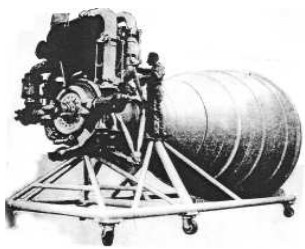
“Rocketdyne F-1”
-As we guessed, the nozzle cooling is regenerative, going down from 5000° C during full operation to a normal operating temperature, due to the fuel that circulates between the two walls in the upper half of the nozzle, before entering the combustion chamber.
-The relatively cool exhaust gas from the turbine traveled through a large tapered manifold forming a film protecting so the nozzle extension from the hot exhaust gas.
-It runs on liquid oxygen and Rep-1. The engine is of a conventional single-chamber design. Its study began in 1959.
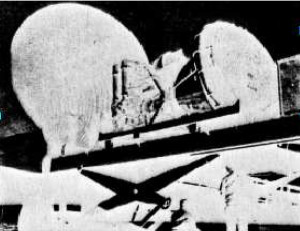
“F-1 prepaired to be transferred”
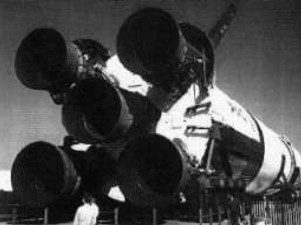
“Cluster of 5 F-1 engines on a Saturn rocket”
-There were many Saturn and Nova vector vehicles with various engine combinations. The F-1A, was the most powerful.
The G-1 for the USAF Nomad rocket is from 1958. It was developed in 1958, and it ran on Hydrazine and LF2.

“Rocketdyne G-1” (PiP)
-The H-1 that delivered 180,000 lbf was designed in 1958, reaching 205,000 lbf of thrust in 1965. It ran on LOX and Kerosene.
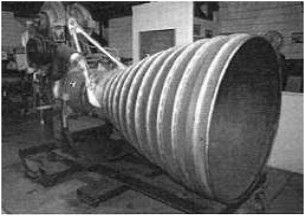
“H-1 at the Arkansas Air Museum”
-The H-1 was used on the Saturn I and individually on the Thor and Jupiter. Each engine has its turbopumps and the ignition is hypergolic, that is, by self-ignition through a catalyst.
-The HG-3 is a 143,000 Kgf engine planned to be used on the Saturn II and IV, in different stages and combinations.
-The J-2 engines, from 1960, used LOX and LH2, and delivered about 105,000 Kgf. They were proposed for and used on the Nova and Saturn projects.
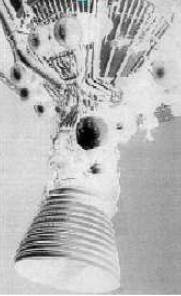
“Rocketdyne J-2” (PiP)
-The J-2S was a simplified version of the previous one. The Saturn carried 5 J-2s in the second stage and only one in the third.

“Rocketdyne LE-3” (PiP)
-The LE-3 is an engine from the year 1970, intended for higher stages such as the Japanese MHI using N2O4/Aerozine-50 for almost 5,500 Kgf.
-Now we come to the military designations LR and their experimental stage XLR. They all have an equivalent reference within Rocketdyne.

“XLR-43-NA-1” (PiP)
-The official reference XLR-43-NA-1 has within Rockertdyne (still North American) that of NA-704.
-It was one of the pioneering American engines since it dates back to 1946. It delivered almost 34,000 Kgf in vacuum, and was planned for the Navaho missile.
-It used Lox/alcohol fuels. The same as fuels that were used by the already old German V-2s.
-Now we introduce the Rocketdyne engine that powered the Redstone rocket.
-That is why it was known as the Redstone rocket engine.
-A simple observation to the main text shows us that it is related to the XLR-43, if it is not the same one.
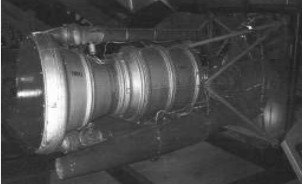
“Redstone rocket engine”
-From this side we see two thick ducts at the foot of the nozzle.
-It is assumed that the nozzle and chamber have a double wall through which fuel circulates to cool them. In other words, a regenerative system.
-There is also another duct from the turbopump that is directed towards the rear, favoring the direction of travel.
-This photo was obtained at NASM.
-For the self-contained LR-64, see also the P4 engine.
-The LR-64 has been used on the AQM-37 Jayhawk supersonic target drone. It gave 1,000 lbs of thrust.
-It used Hydrazine and Red Fuming Nitric Acid as propellants.
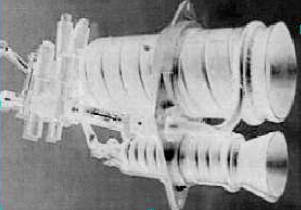
“Rocketdyne LR-64” (PiP)
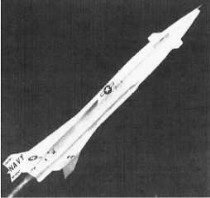
“AQM-37 target drone”
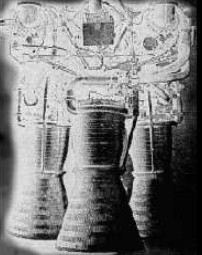
“XLR-71” (PiP)
-In the year 1950, the XLR-71-NA-1 was proposed for the Navaho II in a double mounting.
-The LR-79 was almost identical to the S-3 (see further below).
-By the factory they were referred to as MB-1 and MB-3. They had a single combustion chamber that delivered 77,500 Kgf. approx.
-These engines ran on LOX and Kerosene. and were installed on various Thor, Thor-Agena, or Thor-Able rockets.
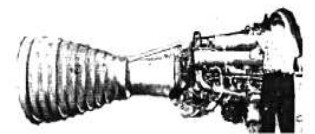
“LR-79”
-The cluster of three G-26 engines became the G-38. They were planned for the Navaho projectiles shown below. Officially it was the XLR-83-NA-1 (NA of North American, since in these years they were made by this brand). This was in 1954.

“G-38 for the Navaho” (PiP)
-The LR-83-NA-1 was the G-28. It gave 61,340 lbf of thrust using Lox/kerosene.
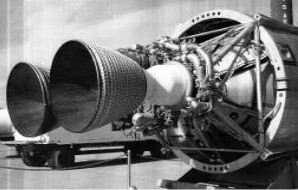
“LR-87, on the Titan II”
-For the Titan launch vehicle there were the LR-87 and LR-91. (The LR-91 was made by Aerojet-General, see).
-Engine combinations (Clusters) were common as we will see in American systems such as the M-2, M-3, etc.
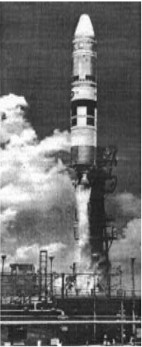
“Titan with three engines”
-The Atlas and Jupiter, were powered by the "M-2 System" that incorporated an LR-105 and two LR-89, plus two LR-101 operated by "vernier" that is, tilting or adjustable to maintain stability and heading. Many of these systems are combinations based on a main “sustaining” engine and two helpers or “boosters”.
-The MA-3 System consists of an LR-105 as a sustainer and two LR-89 boosters plus two LR-101 verniers for control. Although it appears identical to the MA-2 system, the dash numbers for the engines indicated that they were more evolved, lighter and smaller, giving the Atlas ICBM more performance.
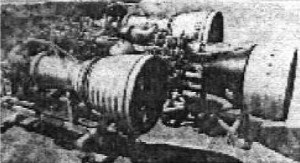
“Sistema MA-5”
-As we will see later, the MA-5 system is made up of an LR-105 as a sustainer and two LR-89 boosters and possibly two L-101 verniers. It is said to be more reliable, easier to maintain and more efficient.
-Thor's MB-3 System with LR-79 and LR-87 engines was more advanced. We also see the LR89 in the trio of engines in the photo of the "LR-105-7 between two LR-89s" further below, they are both of equal size.
-The LR-89 delivered 77,400 kgf - of thrust approx. These engines were designed to act as boosters or launch aids on the first stage of the aforementioned missiles. Although they were used on some Mercury rockets as well.
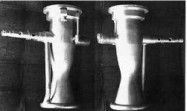
“Two LR-101, Vernier”
-The function of the LR-101 has already been discussed. They ran on Lox/kerosene like the main engines, and gave 1,000 lbf of thrust. In fact they are thruster motors based on Vernier in the aforementioned missiles. In the photograph we see the chambers and they include the injectors and the dome for oxygen. We guess the entrance of the refrigerant propellant through the lower part of the nozzle.
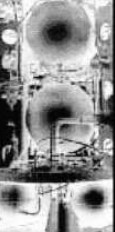
“LR-101-NA-7” (PiP)
-Now we see the use of the LR-101 adapted for use on higher stages and using non-cryogenic fuels such as N2O4 / MMH with 525 Kgf of thrust.
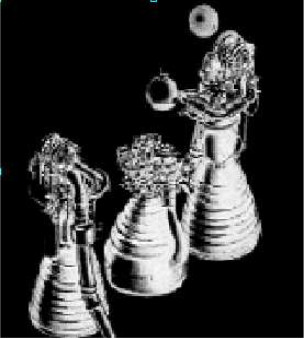
“LR-105-7, between two LR-89s” (PiP)
-The XLR105 engine, of the MA-2 system, was developed in 1958 for the Atlas D, giving 37,000 Kgf. of thrust. The same counts for the LR-105 in the MA-3 system. We see it accompanied by two LR-89.
-The LR-105-5 was intended for the MA-3 system and the LR-105-7 for the MA-5, both gave almost 40,000 kgf of thrust.
-The MA-5A cluster gave about 214,000 Kgf. of thrust and was an update of the MA-5 for the Atlas.
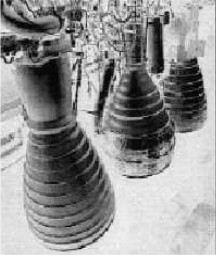
“MA-5A” (PiP)
-Before entering the denominations by reference to the factory, we mention this one with US military XLR-132. (RS-47 at Rocketdyne).
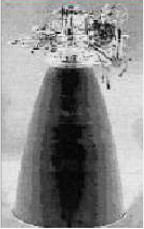
“XLR-132” (PiP)
-The XLR-132, with a long nozzle, gave 1,700 Kgf. and ran on N2O4 / MMH.
-The MB-3 (and MB-1) that were designed for the Delta and Thor-Able-Star missiles, and gave 77,500 Kgf. had their useful life between 1960-69. It was a cluster with LR-79 and LR-87 engines.
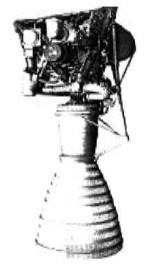
“Motor en MB-3-1”
-There was a colossal engine, the M-1 with 1,200,000 lbf, that was larger than the F-1, and was developed in the days of the Saturn project.

“F-1 on the left and the M-1 on the right”
-The M-34 were very special solid rockets, known as ZELL (ZEro Lenghth Launch), they were used for aircraft takeoff from zero point platforms, that is, launched like a rocket, without the need of a runway.
-This is how the F-100-I “Super Sabre” or the Regulus took off, even the F-104s. This series of solid engines was also extensive, as the M-39 was used by the Walleye.
Later the M-70 and Mk-70 (Condor) for air-to-ground missiles also were solid rocket engines. The Mk36 and 38 were used on the Sparrow. There was the Type 47 that powered the Phoenixes.
-The MB-60 (RS-73, factory name) was developed in 1999 and ran on LOX and LH2 to give about 27,000 Kgf.

“RS-73” (PiP)
-With the letter “P” we have the P4 booster and engine for target drones that we have already seen under the name LR-64. Officially, it consumed storable liquids like Hydyna plus IRFNA. Also LOX/kerosene, depending on how the engine was used. (see LR-64).

“P-7 test”
-The P-7 had a variable thrust from 12,000 to 50,000 lbf and used N2O4 and Aerozine-50.
-The P-8 of the Lance missile used nitric acid and UDMH. This engine was used on the combined carrier and booster system of said missile.
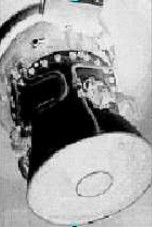
“P-8E-9” (PiP)
-The P-320 was designed jointly with the German company Bölkow in 1966. It was also called Bord 1. It ran on LOX / LH2 propellants.
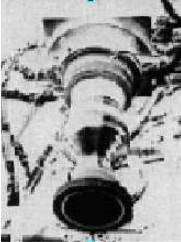
“P-320” (PiP)
-The S-3 engines gave about 80,000 Kgf. of thrust and also powered the Thor and other ballistic missiles.
-We see it exposed in an Astronautical Park.

“Rocketdyne S-3 engine”
-The S-3D engine, intended for the intermediate range Jupiter (IRBM), gave about 150,000 lbf of thrust. It was from the year 1955. The tests were done by the Army Ballistic Missile Agency.
-These engines with the S references contrast with the SE which are small Thrusters for control and maneuvering of satellites and small vessels. We relate the following:

“SE-1 and SE-5”
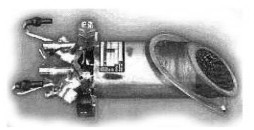
“SE-6”
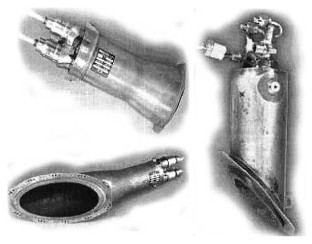
“Three SE-7, series”
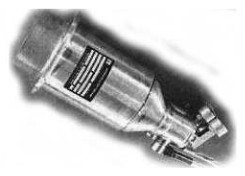
“SE-8”

“SE-9”
-The SE-1 and SE-5 thrusters ran on N2O4 / UDMH. The SE-6, SE7-1 and SE-8 used N2O4 / MMH. The remaining SE-7s ran on LOX/kerosene.
-The SE-9 and SE-10 ran on N2O4/Aerozine-50. The SE-10 was used on the Lunar Descent Module, then the platform would remain on the surface with the motor/s.
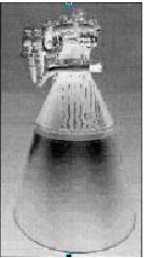
“SE-10” (PiP)
-The SSME engines, known by these initials for the "Space Shuttle Main Engine" that were three of them on the American space shuttle.
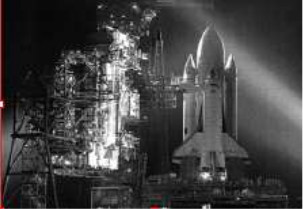
“Space Shuttle on a platform”
-It is slightly similar in size to the F-1, and it is characterized by being reusable and runs on liquid hydrogen and liquid oxygen.
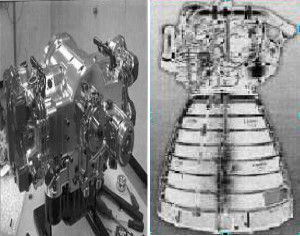
“Rocketdyne SSME engine”
-At Rocketdyne, each engine had the RS-24 reference. It gave 232,300 Kgf of thrust running on Lox / LH2. The propellants for these three engines were stored in a large tank outside attached to the shuttle. There were two solid fuel boosters for takeoff.

“Three Rocketdyne RS-24 on the Shuttle”
-We resume the Boeing/Rocketdyne production, of which we already can see that it is huge. And there will still be secret projects that have not become public, and we do not know about.
-The RM series continues as control engines for space vessels and satellites. The first was a hydrazine-based RM-01.

“RM-01 and RM-05”
The RM-01 gave 0.005 Kgf (5 milligrams) of thrust. The RM-05 used N2O4/MMH, and delivered 2 Kgf. (year 1966).

“RM-25 and RM-100”
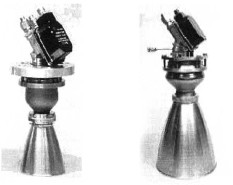
“RM-25 and RM-100”
-The RM-25 gave 11 Kgf and the RM-100 gave 45 Kgf. Both ran on N2H4 and MMH.
-The RM-100T uses Aerozina-50 instead of MMH.

“RM-1600”
-The RM-50 also known as RESA-2 delivered 22 Kgf. while the RESA-5, with RM-1600, gave 725 Kgf.
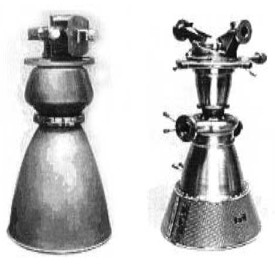
“RM-900 and RM-1500H”
-The ones shown now gave 400 and 680 Kgf respectively.
-We can now mention the KEW engines, also being used for maneuvers and satellite control, from the KEW-1 of 3 Kgf, the KEW-2 of 22 Kgf, the KEW-3 of 45 Kgf or the KEW-4 of 226 kgf. They were produced from 1988 to 1993.

“Kew-1, -2, -3 and -4” (PiP)
-The X-1 from 1957 that ran on LOX/kerosene gave 90,000 Kgf, while the X-8 from 1961 had a specific impulse (Isp) of 408 sec. at sea level.
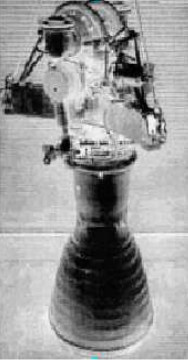
“Rocketdyne X-1” (PiP)
-Do not confuse the 1947 X-1 engine with the Bell X-1 aircraft that used the Bell rocket engine, and with the current Pratt&Whitney/Rocketdyne Scramjet X-1 engine project (CJX-61-1 scramjet engine) for flight Mach 7-10 hypersonics on the X-51A vehicle. Later we will see Rocketdyne's scramjet (Aerospike) engines.
-Now an intermission to deal with Rocketdyne's nuclear experiments. They were done around 1966 with the RN-6 and the NPS-2. In both engines a reactor heated the hydrogen.
-The results were used on the Kiwi-A, and -B, The Nerva, The Phoebus etc. We now see the RN-6 on the left.
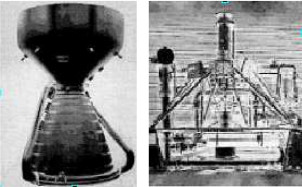
“RN-6 and NPS-2” (PiP)
-The NPS-2 on the right is on a test facility. Both were mentioned for trips into Deep Space.
-We will try to review Rocketdyne's production with a reference list based on the RS letters-, some of which have already been mentioned in this chapter before.

“RS-14” (PiP)
-The RS-14 is a small 142 Kgf motor used to control the Minuteman. And for the same military vehicle there is the RS-1402/3 from the RS-14 family, used to control Pitch, Yaw and Roll. It gave only 10 Kgf.
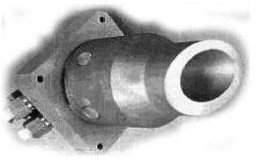
“RS-1402/3”
-We saw the RS-18 in action when, after the Apollo XI Mission's visit to the Moon, the module took off from the platform towards the return path. This is the engine for the manned module.

“RS-18” (PiP)
-It was known as LMDE within the Apollo program, and it delivered around 1,500 Kgf. The RS-18 ran on non-cryogenic fuels such as N2O4/Aerozine-50. It was developed in 1967.
-The RS-19 that was used on air-to-ground missiles, used exotic fuel such as C1F3 and Hydrazine.
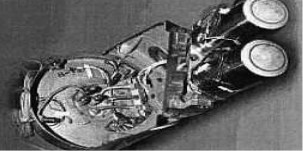
“RS-19”
-The RS-2100, newly designed in 1999, was planned for current and future projects. To be used as boosters or aid for carrier vehicles. It uses LOX and LH2.
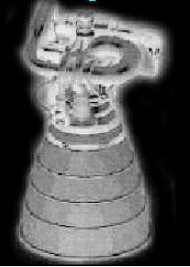
“RS-2100” (PiP)
-However, the RS-2101A engine is from 1968 and was derived from the RS-14. It had an evolution with the RS-2101C.
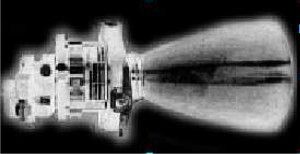
“RS-2101A” (PiP)
-Already in 1968, the RS-22 known as Flexem was made for its ability to vary the thrust between almost 270 to 4,000 lbf and running on C1F3 / Hydrazine.
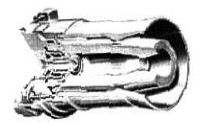
“RS-22”

“RS-23”
-The RS-23 from 1972 we see in the picture above without nozzle, only the combustion chamber. It could carry several nozzles according to its use. It had a thrust of 2,700 Kgf approx.
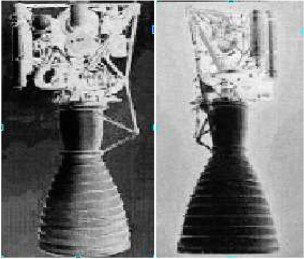
“RS-27 and RS-27A” (PiP)
-The RS-27 made its first flight in 1972 and the last one around 1990 (the RS-27A from 1989 to 1999). It gave about 105,000 Kgf of thrust, running on Lox/kerosene and it was used on the Delta launchers.
-The RS-28 was a small engine of 270 Kgf. that was used on the Space Shuttle for orbit control. It was designed around 1972.

“RS-28”
-The RS-32 has already appeared before in this chapter as upper stages on the Minuteman, derived in turn from the RS-14.
-The RS-34 is a 1,200 kgf rocket motor for axial thrust from 1978. There is an attitude control version with only 31 Kgf. This is an RS-34 Att. Control.
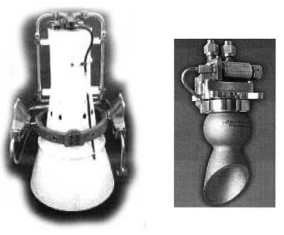
“RS-34 and RS-34 A-C”
-The RS-36 engine was used in axial propulsion experiments with just over 5.5 tons. of thrust. It ran on N2O4 and MMH, and was known as “Sustaining Engine”.

“RS-36” (PiP)
-In 1981, the RS-41 is made for spacecraft giving 1,220 Kgf. From this same year is the RS-42 of only 45 Kgf, for axial control. And the same RS-43 for attitude control and only 2 Kgf of thrust.

“RS-41, RS-42 and RS-43”

“RS-45, attitude control engine”
-The RS-51 was from 1984 and delivered 1,178 Kgf of thrust in a vacuum for spacecraft or space stations.
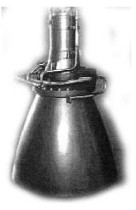
“RS-51 engine”
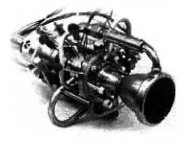
“RS-52”
-The RS-52 is a 11 kgf Thruster for Space Stations as a stabilization engine. It is based on “resistojet” technology.
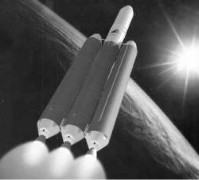
“Delta IV, with RS-68”
-The RS-56 OSA and OBA engines are the MA-5As mentioned at the beginning of this chapter. They are used on the Atlas II A rockets delivering about 40,000 Kgf in a vacuum. They are used on Delta IV launchers.
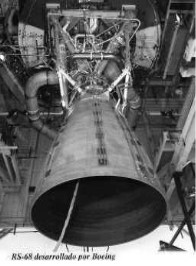
“RS-68”
-The RS-71 is an experimental “Aerospike” type engine that we are looking for more information about.
-The RS-72 built in conjunction (Joint-Venture?) with DASA (German Daimler-Aerospace. For superior carrier rocket stations. It delivered 5,650 Kgf.
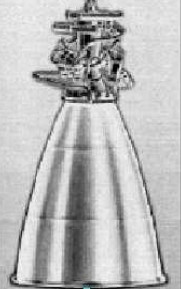
“DASA / Rocketdyne RS-72” (PiP)
-The RS-74 from 1999 is a booster for launch vehicles considered NG (Next Generation), running on LOX / LH2.
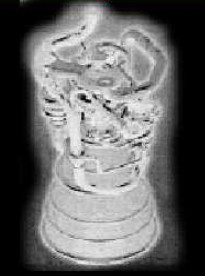
“RS-74” (PiP)
-In 1998 the RS-76 is developed, a reusable motor planned for the Space Shuttle.
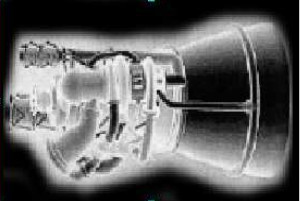
“RS-76” (PiP)
-The RS-77 is original in the sense that it totally differs from the construction system and operating principle of the previous ones.
-For the SOTV project or Solar Orbid Transit Vehicle. It captures solar energy to heat the hydrogen LH2.
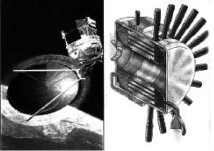
“Nave SOTV y RS-77”
-Of the new engine generations, the RS-82 is considered "Non-Toxic", for being used in upper stages and running on H2O2 / kerosene.

“RS-82” (PiP)
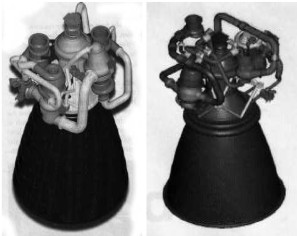
“Two views of the RS-83” (PiP)
-The two views of the RS-83 above are still CAD-CAM designs. For 650,000 lbs of thrust and destined for the new SSME (Space Shuttle Main Engine) program in clear competition with the Aerojet/P&W Cobra.
-Now we come to the most advanced, the Aerospike RS-2200 and XRS-2200, the second known within Rocketdyne as RS-69. (see also RS-71).
-They do not have the classic trumpet-shaped nozzle but are linear. They were designed in 1998, and gave respectable thrust. These engines were also suitable for the highest known speeds.
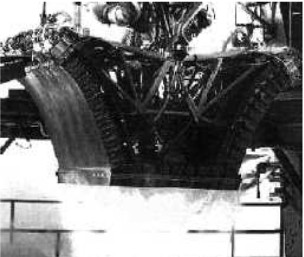
“RS-89 test”
-The thrust of the RS-2200 is more than 224,500 Kgf. in a vaccum. While that of the XRS-2200 is more than 121,500 Kgf in a vacuum. Both were bound for the X-33 spacecraft program, which was cancelled.
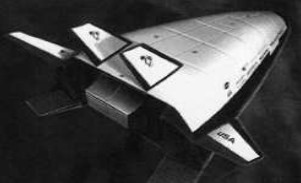
“XRS-2200's rectangular exhaust output on the X-33”
From Appendix 6: Rocketdyne was a pioneer in the study and development of Scramjets or Aerospikes. The one for the X-33 stands out, rectangular in shape and that we see in the following drawing.

“Running aerospike drawing”
-The combustion chambers are linearly arranged on both sides of two slightly concave inclined surfaces causing the jets to stick to these surfaces and join at the end of them.

“An SR-71 testing its Aerospike”
-A real test vehicle was the Lockheed-Martin SR-71, capable of flying on its own at 3 Mach.
-The Lockheed-Martin X-33 has two Aerospikes chambers (see Scramjets in this same appendix), as we see in the following drawing that simulates the device in flight.
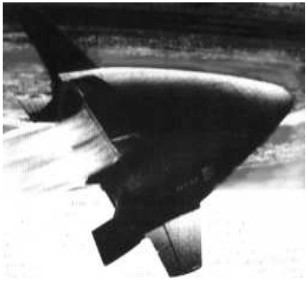
“The X-33 with its two engines running”
-In the main text the MB-3 engines are mentioned with their equivalent official definitions of LR-79.
-At the Pima Air Museum in the USA, we see this equivalence ratified in the LR79-N that they have on display.
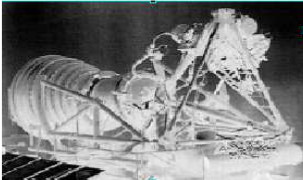
“MB-3 exhibited” (PiP)

“MB-3 or LR79-N” (PiP)
-We received a drawing of the RS-84 that had not yet been mentioned in the main text. It is a reusable engine.
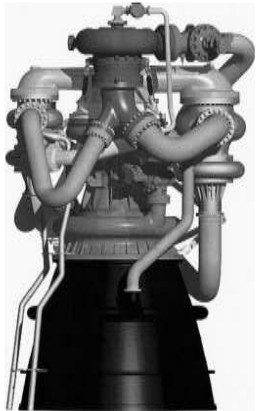
“Rocketdyne RS-84”
-NASA canceled the RS-84 program in 2004. The engine gave 1,064 Klbf of thrust at sea level and 1,130 in a vacuum.
-The specific thrust was delivered during 324 seconds and it consumed LOX/RP-1 (Liquid Oxygen and Kerosene). It was suitable for 100 missions,. It had a variable thrust between 100% and 65%.
-Regarding Rocketdyne's Aerospike X-33, trials continue at Nasa Lewis Research Center and at the John Stennis Center.
-As mentioned in the main text, aerospikes can be linear or annular.
-The X-33 is linear and its main characteristic is that unlike normal rocket engines in which combustion occurs in a chamber, the aerospike has external combustion.
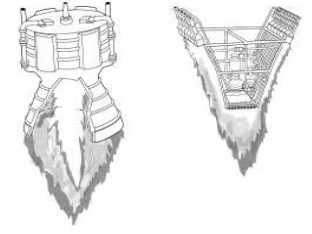
“Comparison of both types of motors”
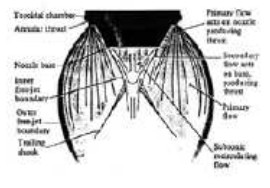
“Aerospike principle schematic”
-Constructively, two sets of small combustion chambers are aligned on both sides of the structure. They provide the primary flow to which the secondary will be added through the lower central part of the engine.
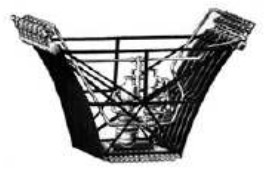
"Aerospike constructive detail"
-We found a drawing of a Rocketdyne A-, for military use in the 1950's. With a chamber and liquid fuels. A long exhaust pipe from the turbopump runs from the top to join the main exhaust. At sea level it gave 75,000 lbf of thrust.

“Rocketdyne A-7 drawing”
-And the A-3 engines that do not appear in the main text we see now in a cluster of 6 of them on the Saturn S-IV, second stage.

“Six A-3 on the Saturn-IV”
-We now have a better picture of the H-1 rocket motor used in the Saturn 1 and 1B precursors to the Saturn V used on the first trip to the Moon.
-They were mounted on the first stage, eight in total producing 205,000 pounds of thrust and burning RP-1 kerosene and liquid oxygen.

“Rocketdyne H-1 at the NASM”
-The J-2 was put on the second stages of the Saturn II and third stages of the Saturn-IVB and V.
-They used liquid hydrogen and oxygen and gave a thrust of 230,000 lbf
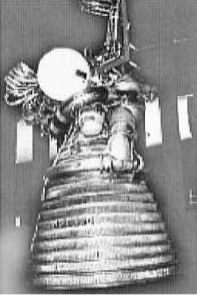
“Rocketdyne J-2”
-On the Saturn V's second stage five J-2 were mounted and on the third one only one.
-Rocketdyne also made the RCS or Reentry Control Systems for the Gemini capsules. These small liquid fueled engines were thrusters of only 25 pounds of thrust, and were installed to correct heading, angles and yaws. They were mounted rigidly.
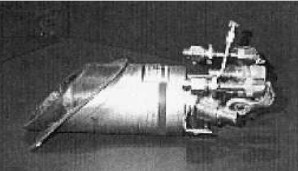
“A RCS for the Gemini project”
-It began to be developed in 1962 when Rocketdyne was a Division of North American Aviation. Its useful life was between 1963 and 1966.
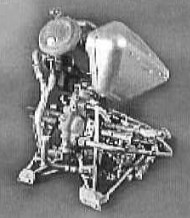
“Vernier rocket engine for the Atlas”
-Although we cannot see the nozzle, we do see the assembly structure that allows movement. The engine gives 1,000 lbf of thrust. It is exhibited at the Smithsonian Museum in Washington.
-The Vernier LR-101 has already been shown in the main text, but now we show it mounted on its support with the joint and the actuator that allows the exhaust to be oriented properly to maneuver.
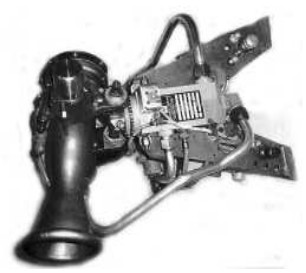
“The complete LR-101”
-And a photo from the Mark E. Wells collection shows us the LR-101 in operation on the Atlas. It was also used by the Atlas-Mercury, the Thor ICBM and the Delta.
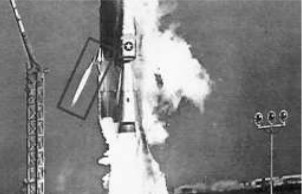
“The LR-101 in acción”
-We see it framed in the inclined rectangle on the left.
From Appendix 9: We have a new <astronautix> relationship. (PeT=mw).
-A-6
-A-7
-AABS
-AEC
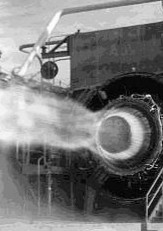
“Annular Aerospike” (PiP)
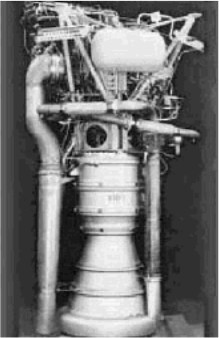
“XLR-43-NA-1” (PiP)
-Annular Aerospike booster
-AR-1
-AMPS-1
-B2C
-ATE
-ASE
-AR2-3
-XLR-43-NA-1
-BORD-1 (P-320 de Bolkow)
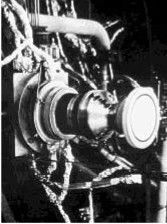
“P-320 (BORD-1)”
-E-1
-EXP-DEFL-10K
-EXP-DEFL-50K
-F-1
-F-1A
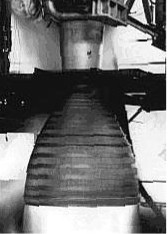
“Rocketdyne E-1” (PiP)
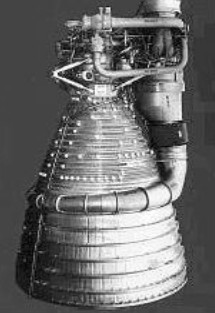
“F-1”

“F-1A” (PiP)
-FLEXEM
--G-1
-G-26 (XLR-83-NA-1)
-G-38 (LR-83-NA-1)

“G-26” (PiP)

“G-38” (PiP)
-H-1
-H-1b
-H-1c
-HG-3
-HG-3-SL
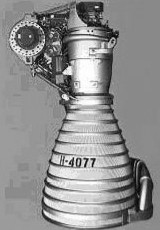
“Rocketdyne H-1”
-IPD
-J-2
-J-2S Linear (+Boeing)
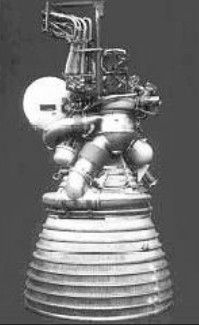
“J-2” (PiP)
-J-2SL
-J-2T-200K
-J-2T-25K
-J2-X

“J-2S”
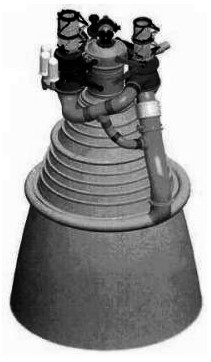
“J-2X” (PiP)
-KEW-1
-KEW-2
-KEW-3
-KEW-4

“Linear Aerospike L-1” (PiP)
-L-1
-L-2
-LR-10
-LR-103 (?)
-LR-105-3
-LR-105-5
-LR-105-7
-LR-121
-LR-54
-LR-64 (P4-1 Booster y Sustainer) (see Harley-Davidson).
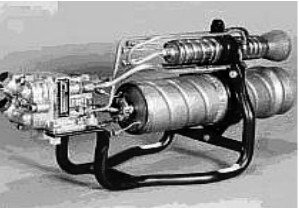
“LR-64” (PiP)
-LR-79-7 (LR-79-NA-7)
-LR-83-NA-1
-MA-1 (XLR-89-1)
-MA-2 (XL-89-5 y LR-105-5)
-MA-3 (LR-89-7 y LR-105-7)

“MA-1 / MA-2”

“MA-5” (PiP)
-MA-5A (RS-56 OBA y OSA)
-MB-1 (LR-79-7)
-MB-3 (MB-3-1)
-MB-3-1
-MB-3-3
-MB-35
-MB-45
-MB-60 (MB-XX)
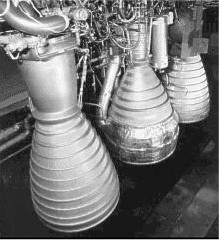
“MA-5A” (PiP)
-MUT
-NAA-75-110
-Nomad (G-1)
-NPS-2
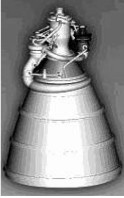
“MB-60” (PiP)
-P-320
-P-4-1 (Booster y Sustainer)
-P-7
-P8E-9
-RM-01
-RM-05
-RM-100A
-RM-100B
-RM-100T
-RM-1-1
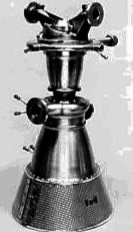
“RM-1500H”
-RM-1-2
-RM-1500H
-RM-1600 (RESA-5)
-RM-25
-RM-25-1
-RM-50 (RESA-2)
-RM-900
-RN-6
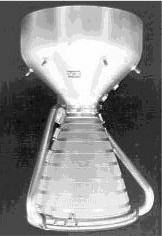
“RN-6” (PiP)
-RS-14
-RS-1402
-RS-1403
-RS-17 (AMPS-1)
-RS-18
-RS-19
-RS-21 (RS-2101A y C)
-RS-2100
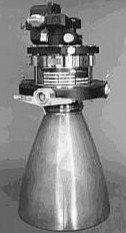
“RS-2101A/C” (PiP)
-RS-22 (Flexem)
-RS-2200 Aerospike
-RS-23
-RS-24 (SSME)
-RS-25 (SSME)
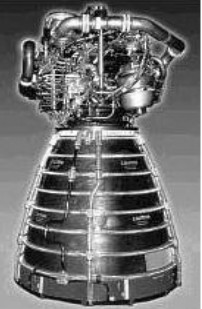
“Space Shuttle Main Engine, SSME”
-RS-27
-RS-27A
-RS-27C
-RS-28
-RS-30 (ASE)
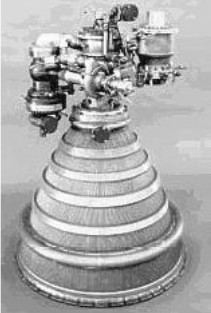
“RS-30, (ASE)”
-RS-32 (R-101-NA-7”
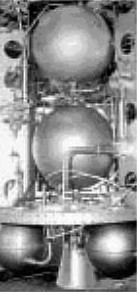
“RS-32” (PiP)
-RS-34 (RS-34-Att. Control)
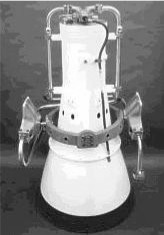
“RS-34” (PiP)
-RS-36 Sustainer
-RS-43
-RS-44 (AEC)
-RS-45
-RS-47 (XLR-132)
-RS-51
-RS-52
-RS-56-OBA y OSA

“RS-36, Sustainer” (PiP)
-RS-68
-RS-68 Regen
-RS-68B
-RS-69
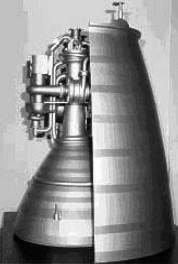
“RS-44, AEC” (PiP)

“RS-47, XLR-132”
-RS-71
-RS-72
-RS-73 (MB-35, 45, 60)
-RS-74
-RS-76
-RS-77
-RS-800
-RS-82
-RS-84
-RS-88

“RS-69, XRS-2200” (PiP)
-RS-X,
-RS-XXX
-S-3
-S-3D
-S-4
-SE-1
-SE-1-1
-SE-1-2
-SE-1-4

“RS-72” (PiP)
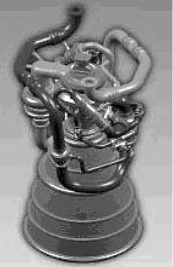
“RS-74” (PiP)

“RS-76” (PiP)
-SE-10
-SE-5-2
-SE-5-3
-SE-6
-SE-7-1
-SE-7-100
-SE-7-25
-SE-7-85
-SE-8
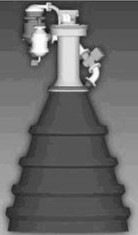
“RS-82” (PiP)
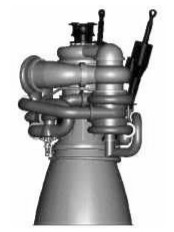
“RS-84”

“RS-88” (PiP)
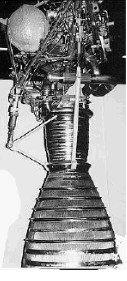
“S-3” (PiP)
-SE-9-3
-Sled Tech.
-SR-122
-SSME
-SSME plus
-SSME study
-STME
-X-1
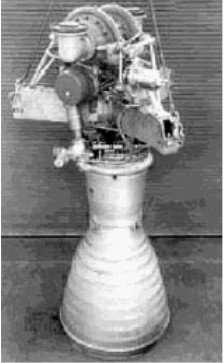
“X-1”
-XLR-43-NA-1
-XLR-71-NA-1
-XLR-89-1
-XLR-89-5
-XRS-2200
-An old photograph of 5 Rocketdyne engines (today Aerojet Rocketdyne) exposed in a warehouse of the factory itself. It can be seen that they are placed on top of some simple palettes.
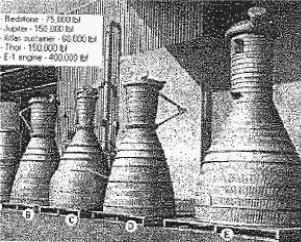
“Photo of five Rocketdyne engines” (PiP=mw)
-From left to right: the first half of which can be seen is the Redstone missile with a thrust of 75,000 lbf.
-The second one is the Jupiter engine, 150,000 lbf.
-The third one is the sustainer for the Atlas, 60,000 lbf.
-The fourth one, which is in the middle of the photo, is the engine of a Titan, with 150,000 lbf.
-Finally, the last one on the right is the E-1 of the year 1957, giving 400,000 lbf. It was intended for the Saturn, but was canceled in favor of the F-1.
-We can see that all of them have a similar architecture.
From Appendix 10: Since 2013 it is the recipient of all the engines designed and built by the brands NAA, Aerojet, P&W, etc (see)
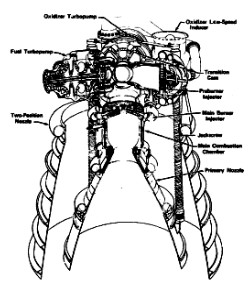
“PW XLRS-129 with expanding nozzle”
-There are a number of engines from the three main American brands P&W, Aerojet and Rocketdyne that are designed with expanding nozzles. The short mode was for takeoff and with the outer skirt extended it was used for higher altitudes. It is a two in one engine solution.
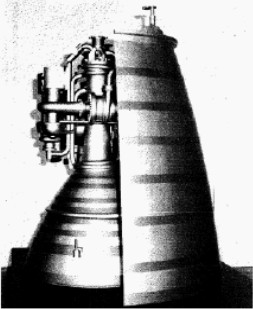
“Another example of an expanding nozzle, the RS-44”
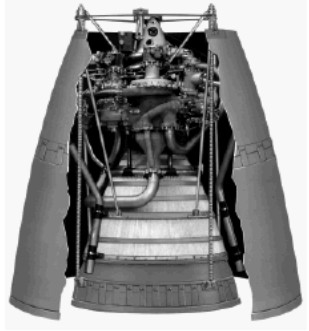
“P&W RL-10B2, another expanding nozzle”
-We can see that the outer skirts are attached to a structure on the main engine by means of endless screws, and that they lower the outer skirt until it is attached to the main one, making it available for high-altitude flights by avoiding dispersion of gases in a vacuum.
-In this case, it is an experiment on the renowned RL-10 engine, widely used in the USA.
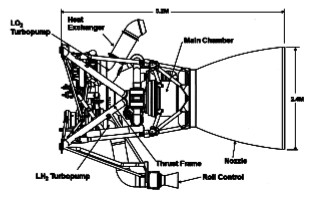
“RS-68”
-Below the RL-20 of unusual architecture, both turbo pumps are located at an angle on top of the chamber.
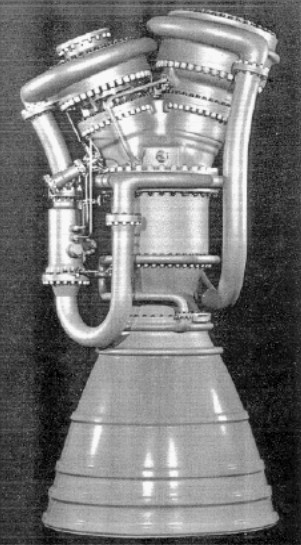
“RL-20”
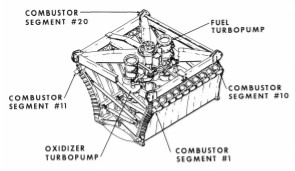
“The Linear Aerospike L1” (see main text.)
Engines of ROCKETDYNE
Model: 16NS-1000
Arquitecture:
Chambers:
Fuels:
Feed System:
Ignition:
Thrust:
Weight:
Model: 16NS1000 Jato
Arquitecture:
Chambers:
Fuels:
Feed System:
Ignition:
Thrust:
Weight:
Model: 50K .E y -D
Arquitecture:
Chambers:
Fuels:
Feed System:
Ignition:
Thrust:
Weight:
Model: 9.9 Hydrolox
Arquitecture:
Chambers:
Fuels:
Feed System:
Ignition:
Thrust:
Weight:
Model: A-3
Arquitecture:
Chambers:
Fuels:
Feed System:
Ignition:
Thrust:
Weight:
Model: A-6 (XLR43-NA-1)
Arquitecture:
Chambers:
Fuels:
Feed System:
Ignition:
Thrust:
Weight:
Model: A-7
Arquitecture:
Chambers:
Fuels:
Feed System:
Ignition:
Thrust:
Weight:
Model: AABS Aerospike
Arquitecture:
Chambers:
Fuels:
Feed System:
Ignition:
Thrust:
Weight:
Model: AEC
Arquitecture:
Chambers:
Fuels:
Feed System:
Ignition:
Thrust:
Weight:
Model: AMPS-1
Arquitecture:
Chambers:
Fuels:
Feed System:
Ignition:
Thrust:
Weight:
Model: AR-1, -2-1
Arquitecture:
Chambers:
Fuels:
Feed System:
Ignition:
Thrust:
Weight:
Model: AR-2, -2, -3,
Arquitecture:
Chambers:
Fuels:
Feed System:
Ignition:
Thrust:
Weight:
Model: ASE
Arquitecture:
Chambers:
Fuels:
Feed System:
Ignition:
Thrust:
Weight:
Model: ATE
Arquitecture:
Chambers:
Fuels:
Feed System:
Ignition:
Thrust:
Weight:
Model: B-1
Arquitecture:
Chambers:
Fuels:
Feed System:
Ignition:
Thrust:
Weight:
Model: B-2C
Arquitecture:
Chambers:
Fuels:
Feed System:
Ignition:
Thrust:
Weight:
Model: E-1 (MA-4)
Arquitecture:
Chambers:
Fuels:
Feed System:
Ignition:
Thrust:
Weight:
Model: Expan/Defl. 10k
Arquitecture:
Chambers:
Fuels:
Feed System:
Ignition:
Thrust:
Weight:
Model: Expan/Defl. 50k
Arquitecture:
Chambers:
Fuels:
Feed System:
Ignition:
Thrust:
Weight:
Model: F-1, -1A (Navaho)
Arquitecture:
Chambers:
Fuels:
Feed System:
Ignition:
Thrust:
Weight:
Model: Flexem
Arquitecture:
Chambers:
Fuels:
Feed System:
Ignition:
Thrust:
Weight:
Model: G-1 (Nomad)
Arquitecture:
Chambers:
Fuels:
Feed System:
Ignition:
Thrust:
Weight:
Model: G-26 (XLR-83-NA-1)
Arquitecture:
Chambers:
Fuels:
Feed System:
Ignition:
Thrust:
Weight:
Model: G-28 (LR-83-NA-1)
Arquitecture:
Chambers:
Fuels:
Feed System:
Ignition:
Thrust:
Weight:
Model: G-38
Arquitecture:
Chambers:
Fuels:
Feed System:
Ignition:
Thrust:
Weight:
Model: H-1, -b, -c
Arquitecture:
Chambers:
Fuels:
Feed System:
Ignition:
Thrust:
Weight:
Model: HG-3. -3SL
Arquitecture:
Chambers:
Fuels:
Feed System:
Ignition:
Thrust:
Weight:
Model: IPD
Arquitecture:
Chambers:
Fuels:
Feed System:
Ignition:
Thrust:
Weight:
Model: J-2 Plug nozzle
Arquitecture:
Chambers:
Fuels:
Feed System:
Ignition:
Thrust:
Weight:
Model: J-2, -S, -SL
Arquitecture:
Chambers:
Fuels:
Feed System:
Ignition:
Thrust:
Weight:
Model: J-2S Linear Spike
Arquitecture:
Chambers:
Fuels:
Feed System:
Ignition:
Thrust:
Weight:
Model: J-2T-200K, -250K
Arquitecture:
Chambers:
Fuels:
Feed System:
Ignition:
Thrust:
Weight:
Model: J-2X
Arquitecture:
Chambers:
Fuels:
Feed System:
Ignition:
Thrust:
Weight:
Model: KEW-1, -2, -3, -4
Arquitecture:
Chambers:
Fuels:
Feed System:
Ignition:
Thrust:
Weight:
Model: L-1 Linear Aerospike
Arquitecture:
Chambers:
Fuels:
Feed System:
Ignition:
Thrust:
Weight:
Model: L-2 Linear Aerospike
Arquitecture:
Chambers:
Fuels:
Feed System:
Ignition:
Thrust:
Weight:
Model: LE-3
Arquitecture:
Chambers:
Fuels:
Feed System:
Ignition:
Thrust:
Weight:
Model: LMDE
Arquitecture:
Chambers:
Fuels:
Feed System:
Ignition:
Thrust:
Weight:
Model: LR-101 (RS-32), -11, -NA-7,
Arquitecture:
Chambers:
Fuels:
Feed System:
Ignition:
Thrust:
Weight:
Model: LR-103
Arquitecture:
Chambers:
Fuels:
Feed System:
Ignition:
Thrust:
Weight:
Model: LR-105. -3, -5, -7
Arquitecture:
Chambers:
Fuels:
Feed System:
Ignition:
Thrust:
Weight:
Model: LR-107
Arquitecture:
Chambers:
Fuels:
Feed System:
Ignition:
Thrust:
Weight:
Model: LR-121 (AR2-NA-1)
Arquitecture:
Chambers:
Fuels:
Feed System:
Ignition:
Thrust:
Weight:
Model: LR-42 (XLR42-NA-1)
Arquitecture:
Chambers:
Fuels:
Feed System:
Ignition:
Thrust:
Weight:
Model: LR-54 (XLR54-NA-1)
Arquitecture:
Chambers:
Fuels:
Feed System:
Ignition:
Thrust:
Weight:
Model: LR-64 (P4-1) (Booster and Sustainer)
Arquitecture:
Chambers:
Fuels:
Feed System:
Ignition:
Thrust:
Weight:
Model: LR-79, -N, -7, -NA-7,
Arquitecture:
Chambers:
Fuels:
Feed System:
Ignition:
Thrust:
Weight:
Model: LR-83
Arquitecture:
Chambers:
Fuels:
Feed System:
Ignition:
Thrust:
Weight:
Model: LR-87
Arquitecture:
Chambers:
Fuels:
Feed System:
Ignition:
Thrust:
Weight:
Model: LR-89 (XLR89-1, -5)
Arquitecture:
Chambers:
Fuels:
Feed System:
Ignition:
Thrust:
Weight:
Model: LR-89-5, -7
Arquitecture:
Chambers:
Fuels:
Feed System:
Ignition:
Thrust:
Weight:
Model: LR-91
Arquitecture:
Chambers:
Fuels:
Feed System:
Ignition:
Thrust:
Weight:
Model: M-1
Arquitecture:
Chambers:
Fuels:
Feed System:
Ignition:
Thrust:
Weight:
Model: M-2
Arquitecture:
Chambers:
Fuels:
Feed System:
Ignition:
Thrust:
Weight:
Model: M-3
Arquitecture:
Chambers:
Fuels:
Feed System:
Ignition:
Thrust:
Weight:
Model: M-34 (ZEL)
Arquitecture:
Chambers:
Fuels:
Feed System:
Ignition:
Thrust:
Weight:
Model: M-39
Arquitecture:
Chambers:
Fuels:
Feed System:
Ignition:
Thrust:
Weight:
Model: M-70
Arquitecture:
Chambers:
Fuels:
Feed System:
Ignition:
Thrust:
Weight:
Model: MA-1
Arquitecture:
Chambers:
Fuels:
Feed System:
Ignition:
Thrust:
Weight:
Model: MA-2
Arquitecture:
Chambers:
Fuels:
Feed System:
Ignition:
Thrust:
Weight:
Model: MA-3
Arquitecture:
Chambers:
Fuels:
Feed System:
Ignition:
Thrust:
Weight:
Model: MA-5, -A
Arquitecture:
Chambers:
Fuels:
Feed System:
Ignition:
Thrust:
Weight:
Model: MB-1
Arquitecture:
Chambers:
Fuels:
Feed System:
Ignition:
Thrust:
Weight:
Model: MB-1/LR79-7
Arquitecture:
Chambers:
Fuels:
Feed System:
Ignition:
Thrust:
Weight:
Model: MB-3 (MB-3-3), Press Mode, -3-1, -3-3, -3-J
Arquitecture:
Chambers:
Fuels:
Feed System:
Ignition:
Thrust:
Weight:
Model: MB-35
Arquitecture:
Chambers:
Fuels:
Feed System:
Ignition:
Thrust:
Weight:
Model: MB-45
Arquitecture:
Chambers:
Fuels:
Feed System:
Ignition:
Thrust:
Weight:
Model: MB-60 (alt. MB-XX)
Arquitecture:
Chambers:
Fuels:
Feed System:
Ignition:
Thrust:
Weight:
Model: MB-60 (RS-73)
Arquitecture:
Chambers:
Fuels:
Feed System:
Ignition:
Thrust:
Weight:
Model: MK-25
Arquitecture:
Chambers:
Fuels:
Feed System:
Ignition:
Thrust:
Weight:
Model: MK-34
Arquitecture:
Chambers:
Fuels:
Feed System:
Ignition:
Thrust:
Weight:
Model: MK-36
Arquitecture:
Chambers:
Fuels:
Feed System:
Ignition:
Thrust:
Weight:
Model: MK-38
Arquitecture:
Chambers:
Fuels:
Feed System:
Ignition:
Thrust:
Weight:
Model: MK-39
Arquitecture:
Chambers:
Fuels:
Feed System:
Ignition:
Thrust:
Weight:
Model: MK-47
Arquitecture:
Chambers:
Fuels:
Feed System:
Ignition:
Thrust:
Weight:
Model: MK-70 Condor
Arquitecture:
Chambers:
Fuels:
Feed System:
Ignition:
Thrust:
Weight:
Model: MUT
Arquitecture:
Chambers:
Fuels:
Feed System:
Ignition:
Thrust:
Weight:
Model: NAA Rocketdyne 75-110 A (Redstone)
Arquitecture:
Chambers:
Fuels:
Feed System:
Ignition:
Thrust:
Weight:
Model: NPS-2
Arquitecture:
Chambers:
Fuels:
Feed System:
Ignition:
Thrust:
Weight:
Model: NPS-2 Nuclear/lh2
Arquitecture:
Chambers:
Fuels:
Feed System:
Ignition:
Thrust:
Weight:
Model: P-320 (Bord 1)
Arquitecture:
Chambers:
Fuels:
Feed System:
Ignition:
Thrust:
Weight:
Model: P-4-1 booster and sustainer
Arquitecture:
Chambers:
Fuels:
Feed System:
Ignition:
Thrust:
Weight:
Model: P-7
Arquitecture:
Chambers:
Fuels:
Feed System:
Ignition:
Thrust:
Weight:
Model: P-8E-9
Arquitecture:
Chambers:
Fuels:
Feed System:
Ignition:
Thrust:
Weight:
Model: RCS
Arquitecture:
Chambers:
Fuels:
Feed System:
Ignition:
Thrust:
Weight:
Model: RESA-2
Arquitecture:
Chambers:
Fuels:
Feed System:
Ignition:
Thrust:
Weight:
Model: RESA-5
Arquitecture:
Chambers:
Fuels:
Feed System:
Ignition:
Thrust:
Weight:
Model: RL-20
Arquitecture:
Chambers:
Fuels:
Feed System:
Ignition:
Thrust:
Weight:
Model: RM-01
Arquitecture:
Chambers:
Fuels:
Feed System:
Ignition:
Thrust:
Weight:
Model: RM-05
Arquitecture:
Chambers:
Fuels:
Feed System:
Ignition:
Thrust:
Weight:
Model: RM-1-1
Arquitecture:
Chambers:
Fuels:
Feed System:
Ignition:
Thrust:
Weight:
Model: RM-1-2
Arquitecture:
Chambers:
Fuels:
Feed System:
Ignition:
Thrust:
Weight:
Model: RM-100, -T
Arquitecture:
Chambers:
Fuels:
Feed System:
Ignition:
Thrust:
Weight:
Model: RM-100A
Arquitecture:
Chambers:
Fuels:
Feed System:
Ignition:
Thrust:
Weight:
Model: RM-100B
Arquitecture:
Chambers:
Fuels:
Feed System:
Ignition:
Thrust:
Weight:
Model: RM-110
Arquitecture:
Chambers:
Fuels:
Feed System:
Ignition:
Thrust:
Weight:
Model: RM-1500H
Arquitecture:
Chambers:
Fuels:
Feed System:
Ignition:
Thrust:
Weight:
Model: RM-1600 (RESA-5)
Arquitecture:
Chambers:
Fuels:
Feed System:
Ignition:
Thrust:
Weight:
Model: RM-25
Arquitecture:
Chambers:
Fuels:
Feed System:
Ignition:
Thrust:
Weight:
Model: RM-25-1
Arquitecture:
Chambers:
Fuels:
Feed System:
Ignition:
Thrust:
Weight:
Model: RM-50 (RESA-2)
Arquitecture:
Chambers:
Fuels:
Feed System:
Ignition:
Thrust:
Weight:
Model: RM-900
Arquitecture:
Chambers:
Fuels:
Feed System:
Ignition:
Thrust:
Weight:
Model: RN-6
Arquitecture:
Chambers:
Fuels:
Feed System:
Ignition:
Thrust:
Weight:
Model: RS-14
Arquitecture:
Chambers:
Fuels:
Feed System:
Ignition:
Thrust:
Weight:
Model: RS-1402
Arquitecture:
Chambers:
Fuels:
Feed System:
Ignition:
Thrust:
Weight:
Model: RS-1403 (RS-140-3?)
Arquitecture:
Chambers:
Fuels:
Feed System:
Ignition:
Thrust:
Weight:
Model: RS-17
Arquitecture:
Chambers:
Fuels:
Feed System:
Ignition:
Thrust:
Weight:
Model: RS-18
Arquitecture:
Chambers:
Fuels:
Feed System:
Ignition:
Thrust:
Weight:
Model: RS-18 (Lunar Module)
Arquitecture:
Chambers:
Fuels:
Feed System:
Ignition:
Thrust:
Weight:
Model: RS-19
Arquitecture:
Chambers:
Fuels:
Feed System:
Ignition:
Thrust:
Weight:
Model: RS-2 (Mariner)
Arquitecture:
Chambers:
Fuels:
Feed System:
Ignition:
Thrust:
Weight:
Model: RS-21
Arquitecture:
Chambers:
Fuels:
Feed System:
Ignition:
Thrust:
Weight:
Model: RS-2100
Arquitecture:
Chambers:
Fuels:
Feed System:
Ignition:
Thrust:
Weight:
Model: RS-2101
Arquitecture:
Chambers:
Fuels:
Feed System:
Ignition:
Thrust:
Weight:
Model: RS-2101A, -C
Arquitecture:
Chambers:
Fuels:
Feed System:
Ignition:
Thrust:
Weight:
Model: RS-22 (Flexem)
Arquitecture:
Chambers:
Fuels:
Feed System:
Ignition:
Thrust:
Weight:
Model: RS-2200 (XRS-2200)
Arquitecture:
Chambers:
Fuels:
Feed System:
Ignition:
Thrust:
Weight:
Model: RS-23
Arquitecture:
Chambers:
Fuels:
Feed System:
Ignition:
Thrust:
Weight:
Model: RS-24 (SSME) (Shuttle)
Arquitecture:
Chambers:
Fuels:
Feed System:
Ignition:
Thrust:
Weight:
Model: RS-25 (SSME) (Shuttle), RS-25E
Arquitecture:
Chambers:
Fuels:
Feed System:
Ignition:
Thrust:
Weight:
Model: RS-27, -A
Arquitecture:
Chambers:
Fuels:
Feed System:
Ignition:
Thrust:
Weight:
Model: RS-270
Arquitecture:
Chambers:
Fuels:
Feed System:
Ignition:
Thrust:
Weight:
Model: RS-2701
Arquitecture:
Chambers:
Fuels:
Feed System:
Ignition:
Thrust:
Weight:
Model: RS-27A
Arquitecture:
Chambers:
Fuels:
Feed System:
Ignition:
Thrust:
Weight:
Model: RS-27C
Arquitecture:
Chambers:
Fuels:
Feed System:
Ignition:
Thrust:
Weight:
Model: RS-28
Arquitecture:
Chambers:
Fuels:
Feed System:
Ignition:
Thrust:
Weight:
Model: RS-30 (ASE)
Arquitecture:
Chambers:
Fuels:
Feed System:
Ignition:
Thrust:
Weight:
Model: RS-32 (LR-101-NA-7)
Arquitecture:
Chambers:
Fuels:
Feed System:
Ignition:
Thrust:
Weight:
Model: RS-34, Att. Control
Arquitecture:
Chambers:
Fuels:
Feed System:
Ignition:
Thrust:
Weight:
Model: RS-36, Sustainer HOE
Arquitecture:
Chambers:
Fuels:
Feed System:
Ignition:
Thrust:
Weight:
Model: RS-41
Arquitecture:
Chambers:
Fuels:
Feed System:
Ignition:
Thrust:
Weight:
Model: RS-42
Arquitecture:
Chambers:
Fuels:
Feed System:
Ignition:
Thrust:
Weight:
Model: RS-43
Arquitecture:
Chambers:
Fuels:
Feed System:
Ignition:
Thrust:
Weight:
Model: RS-44, AEC
Arquitecture:
Chambers:
Fuels:
Feed System:
Ignition:
Thrust:
Weight:
Model: RS-45
Arquitecture:
Chambers:
Fuels:
Feed System:
Ignition:
Thrust:
Weight:
Model: RS-47 (XLR-132)
Arquitecture:
Chambers:
Fuels:
Feed System:
Ignition:
Thrust:
Weight:
Model: RS-51
Arquitecture:
Chambers:
Fuels:
Feed System:
Ignition:
Thrust:
Weight:
Model: RS-52
Arquitecture:
Chambers:
Fuels:
Feed System:
Ignition:
Thrust:
Weight:
Model: RS-56 SA, OSA y OBA (MA-5A)
Arquitecture:
Chambers:
Fuels:
Feed System:
Ignition:
Thrust:
Weight:
Model: RS-68, Regen, -A, -B
Arquitecture:
Chambers:
Fuels:
Feed System:
Ignition:
Thrust:
Weight:
Model: RS-69 (XRS-2200)
Arquitecture:
Chambers:
Fuels:
Feed System:
Ignition:
Thrust:
Weight:
Model: RS-71
Arquitecture:
Chambers:
Fuels:
Feed System:
Ignition:
Thrust:
Weight:
Model: RS-72
Arquitecture:
Chambers:
Fuels:
Feed System:
Ignition:
Thrust:
Weight:
Model: RS-73 (MB-35, MB-45 y MB-60)
Arquitecture:
Chambers:
Fuels:
Feed System:
Ignition:
Thrust:
Weight:
Model: RS-74
Arquitecture:
Chambers:
Fuels:
Feed System:
Ignition:
Thrust:
Weight:
Model: RS-76
Arquitecture:
Chambers:
Fuels:
Feed System:
Ignition:
Thrust:
Weight:
Model: RS-77
Arquitecture:
Chambers:
Fuels:
Feed System:
Ignition:
Thrust:
Weight:
Model: RS-800
Arquitecture:
Chambers:
Fuels:
Feed System:
Ignition:
Thrust:
Weight:
Model: RS-83
Arquitecture:
Chambers:
Fuels:
Feed System:
Ignition:
Thrust:
Weight:
Model: RS-84
Arquitecture:
Chambers:
Fuels:
Feed System:
Ignition:
Thrust:
Weight:
Model: RS-88
Arquitecture:
Chambers:
Fuels:
Feed System:
Ignition:
Thrust:
Weight:
Model: RS-X
Arquitecture:
Chambers:
Fuels:
Feed System:
Ignition:
Thrust:
Weight:
Model: RS-XXX
Arquitecture:
Chambers:
Fuels:
Feed System:
Ignition:
Thrust:
Weight:
Model: RS.60
Arquitecture:
Chambers:
Fuels:
Feed System:
Ignition:
Thrust:
Weight:
Model: RS.82
Arquitecture:
Chambers:
Fuels:
Feed System:
Ignition:
Thrust:
Weight:
Model: S-1
Arquitecture:
Chambers:
Fuels:
Feed System:
Ignition:
Thrust:
Weight:
Model: S-3, -3D
Arquitecture:
Chambers:
Fuels:
Feed System:
Ignition:
Thrust:
Weight:
Model: S-3D / E / F
Arquitecture:
Chambers:
Fuels:
Feed System:
Ignition:
Thrust:
Weight:
Model: S-4
Arquitecture:
Chambers:
Fuels:
Feed System:
Ignition:
Thrust:
Weight:
Model: SE-1, -1.1,
Arquitecture:
Chambers:
Fuels:
Feed System:
Ignition:
Thrust:
Weight:
Model: SE-10
Arquitecture:
Chambers:
Fuels:
Feed System:
Ignition:
Thrust:
Weight:
Model: SE-2
Arquitecture:
Chambers:
Fuels:
Feed System:
Ignition:
Thrust:
Weight:
Model: SE-4
Arquitecture:
Chambers:
Fuels:
Feed System:
Ignition:
Thrust:
Weight:
Model: SE-5, 2/3
Arquitecture:
Chambers:
Fuels:
Feed System:
Ignition:
Thrust:
Weight:
Model: SE-6
Arquitecture:
Chambers:
Fuels:
Feed System:
Ignition:
Thrust:
Weight:
Model: SE-7, -1,
Arquitecture:
Chambers:
Fuels:
Feed System:
Ignition:
Thrust:
Weight:
Model: SE-7-100
Arquitecture:
Chambers:
Fuels:
Feed System:
Ignition:
Thrust:
Weight:
Model: SE-7-25
Arquitecture:
Chambers:
Fuels:
Feed System:
Ignition:
Thrust:
Weight:
Model: SE-785
Arquitecture:
Chambers:
Fuels:
Feed System:
Ignition:
Thrust:
Weight:
Model: SE-8
Arquitecture:
Chambers:
Fuels:
Feed System:
Ignition:
Thrust:
Weight:
Model: SE-9, -5
Arquitecture:
Chambers:
Fuels:
Feed System:
Ignition:
Thrust:
Weight:
Model: SE-D
Arquitecture:
Chambers:
Fuels:
Feed System:
Ignition:
Thrust:
Weight:
Model: Sled Rockets Tech.
Arquitecture:
Chambers:
Fuels:
Feed System:
Ignition:
Thrust:
Weight:
Model: SOTV
Arquitecture:
Chambers:
Fuels:
Feed System:
Ignition:
Thrust:
Weight:
Model: SR-122
Arquitecture:
Chambers:
Fuels:
Feed System:
Ignition:
Thrust:
Weight:
Model: SSME booster
Arquitecture:
Chambers:
Fuels:
Feed System:
Ignition:
Thrust:
Weight:
Model: STME
Arquitecture:
Chambers:
Fuels:
Feed System:
Ignition:
Thrust:
Weight:
Model: X-1
Arquitecture:
Chambers:
Fuels:
Feed System:
Ignition:
Thrust:
Weight:
Model: X-33 Scramjets (Aerospikes)
Arquitecture:
Chambers:
Fuels:
Feed System:
Ignition:
Thrust:
Weight:
Model: X-8
Arquitecture:
Chambers:
Fuels:
Feed System:
Ignition:
Thrust:
Weight:
Model: XLR-101
Arquitecture:
Chambers:
Fuels:
Feed System:
Ignition:
Thrust:
Weight:
Model: XLR-105 (MA-5)
Arquitecture:
Chambers:
Fuels:
Feed System:
Ignition:
Thrust:
Weight:
Model: XLR-105, -5
Arquitecture:
Chambers:
Fuels:
Feed System:
Ignition:
Thrust:
Weight:
Model: XLR-132 (RS-47)
Arquitecture:
Chambers:
Fuels:
Feed System:
Ignition:
Thrust:
Weight:
Model: XLR-41-NA-1 / V2
Arquitecture:
Chambers:
Fuels:
Feed System:
Ignition:
Thrust:
Weight:
Model: XLR-43
Arquitecture:
Chambers:
Fuels:
Feed System:
Ignition:
Thrust:
Weight:
Model: XLR-43-NA-1 (NA-704)
Arquitecture:
Chambers:
Fuels:
Feed System:
Ignition:
Thrust:
Weight:
Model: XLR-71 (XLR-71-NA-1)
Arquitecture:
Chambers:
Fuels:
Feed System:
Ignition:
Thrust:
Weight:
Model: XLR-71-NA-1
Arquitecture:
Chambers:
Fuels:
Feed System:
Ignition:
Thrust:
Weight:
Model: XLR-83-NA-1
Arquitecture:
Chambers:
Fuels:
Feed System:
Ignition:
Thrust:
Weight:
Model: XLR-89
Arquitecture:
Chambers:
Fuels:
Feed System:
Ignition:
Thrust:
Weight:
Model: XLR41-NA-1
Arquitecture:
Chambers:
Fuels:
Feed System:
Ignition:
Thrust:
Weight:
Model: XRS-2200 (RS-69)
Arquitecture:
Chambers:
Fuels:
Feed System:
Ignition:
Thrust:
Weight:


